what percentage of people prefer texting than face to face interactio
When walking down the school hallway, I run into groups of students on either side in small circles with their cliques. You would wait close friends to exist conversing and talking to each other since they got out of bed early that morn to talk before classes get-go. To my surprise, no one is talking. They are not even staring at each other. Instead, each and everyone of them is staring down at their petty rectangular device in their hand that seems to give them much more satisfaction than talking to their friends. Information technology seems that they have lost all communication skills and are simply capable of moving their fingers to text their friend back. Since the invention of texting and the ability for letters to exist sent at a rapid speed, Teens have shifted from conventional conversational methods to communicating mostly through the utilise of texting and emojis. In gild to see if this switch from talking face-to-face to talking over text was true, I surveyed fifty teens ranging from thirteen-18 years of age from Fulton County High Schools. I gave each teen surveyed four scenarios in which they had to choose what form of communication they would be most comfy with: texting, calling, or face-to-face. The results were very surprising.
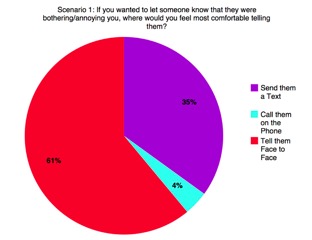 In this scenario, most of the students that I surveyed answered that they would tell the person face to face if they were annoying them. Although, 35% of the teens surveyed chose texting them. Anna Shamis, a 17 twelvemonth old junior from Norcross High schoolhouse explained why she chose contiguous in this scenario. "When texting, at that place are often misunderstandings and misinterpretations, so contiguous is the virtually effective mode to communicate and share emotions." Perchance the reason teens are so inclined to text instead of talking confront-to-face up is that they are agape to say the wrong thing and texting gives them more time to retrieve about what to say and phrase it in a fashion that will not injure the other person.
In this scenario, most of the students that I surveyed answered that they would tell the person face to face if they were annoying them. Although, 35% of the teens surveyed chose texting them. Anna Shamis, a 17 twelvemonth old junior from Norcross High schoolhouse explained why she chose contiguous in this scenario. "When texting, at that place are often misunderstandings and misinterpretations, so contiguous is the virtually effective mode to communicate and share emotions." Perchance the reason teens are so inclined to text instead of talking confront-to-face up is that they are agape to say the wrong thing and texting gives them more time to retrieve about what to say and phrase it in a fashion that will not injure the other person.
In this scenario, the number of teens who chose texting their shell and talking face-to-confront with their vanquish were about the same. 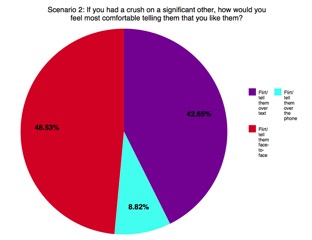 Even though information technology might be an extremely hard matter to come up to the person you like and tell them you accept feelings for them, it is much ameliorate to do it in person. It is a scary thing to know that you have a chance of getting a bad response, only information technology shows that y'all respect the person if you have the backbone to approach them virtually your feelings instead of typing them into a pocket-sized text box. Brenda Hernandez, a xvi year old sophomore at Alpharetta Loftier School said, "I feel similar in order to properly accept a conversation most your feelings it should be washed in person. That way you can read their reactions. The conversation seems more intimate."
Even though information technology might be an extremely hard matter to come up to the person you like and tell them you accept feelings for them, it is much ameliorate to do it in person. It is a scary thing to know that you have a chance of getting a bad response, only information technology shows that y'all respect the person if you have the backbone to approach them virtually your feelings instead of typing them into a pocket-sized text box. Brenda Hernandez, a xvi year old sophomore at Alpharetta Loftier School said, "I feel similar in order to properly accept a conversation most your feelings it should be washed in person. That way you can read their reactions. The conversation seems more intimate."
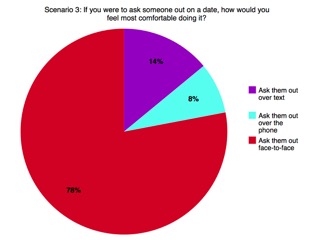 In this scenario, a significant amount of teens chose asking their significant other out confront-to-confront. This shows that teens know the value of confronting someone about feelings face-to-face is way more respectable and courageous than sending them a text filled with middle emojis. Ben Hutkoff, a xvi year old sophomore from Milton High School chose this option and said, "It'due south hard to express emotions the same way over text. Also, being able to analyze someone's face while they talk is of import in understanding what they feel every bit well."
In this scenario, a significant amount of teens chose asking their significant other out confront-to-confront. This shows that teens know the value of confronting someone about feelings face-to-face is way more respectable and courageous than sending them a text filled with middle emojis. Ben Hutkoff, a xvi year old sophomore from Milton High School chose this option and said, "It'due south hard to express emotions the same way over text. Also, being able to analyze someone's face while they talk is of import in understanding what they feel every bit well."
All of the previous scenarios had the bulk of teens picking face-to-face as their answer. For this Scenario, nearly teens picked the 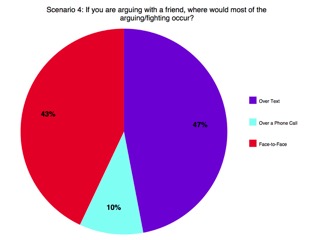 texting option. Zoe Ferrard, a 15 year quondam sophomore from Milton High School, explained it by saying, "In this state of affairs, texting allows me to procedure what I want to say. This way I won't blurt out something or hurt someone past being rude. Past planning out what I say, I tin can avoid creating a bigger issue." Based on teen interviews, many teens are more than comfortable with arguing with their friend over text because they are afraid they volition say something unnecessary or see their injure reaction. Although phrasing words correctly in an statement is a good idea, the comfortable aspects of texting while arguing leads to problems such as bullying. In a contempo story about the Kik messaging app, the New York Times reported that Kik'south unlimited and free messaging system leads to teens beingness comfortable with texting and leads to people bullying or being the victims of cyberbullying.
texting option. Zoe Ferrard, a 15 year quondam sophomore from Milton High School, explained it by saying, "In this state of affairs, texting allows me to procedure what I want to say. This way I won't blurt out something or hurt someone past being rude. Past planning out what I say, I tin can avoid creating a bigger issue." Based on teen interviews, many teens are more than comfortable with arguing with their friend over text because they are afraid they volition say something unnecessary or see their injure reaction. Although phrasing words correctly in an statement is a good idea, the comfortable aspects of texting while arguing leads to problems such as bullying. In a contempo story about the Kik messaging app, the New York Times reported that Kik'south unlimited and free messaging system leads to teens beingness comfortable with texting and leads to people bullying or being the victims of cyberbullying.
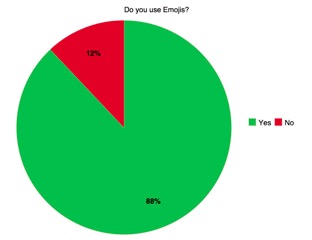 Along with the actual texts that teens write to express feelings, emojis have made it easier for teens to detect a face that describes their mood and transport it to their friends. I too asked teens that I surveyed whether or non they use emojis. Based on the data to the left, you can probably tell well-nigh teens said "Absolutely!" Jack Hurst, a 16 year old sophomore at Milton High Schoolhouse said, "I utilise emojis considering I am incapable of showing emotions any other way."
Along with the actual texts that teens write to express feelings, emojis have made it easier for teens to detect a face that describes their mood and transport it to their friends. I too asked teens that I surveyed whether or non they use emojis. Based on the data to the left, you can probably tell well-nigh teens said "Absolutely!" Jack Hurst, a 16 year old sophomore at Milton High Schoolhouse said, "I utilise emojis considering I am incapable of showing emotions any other way."
Teens spend a lot of time on their phone throughout the solar day (run into graph on right), whether it's on Instagram or checking the latest 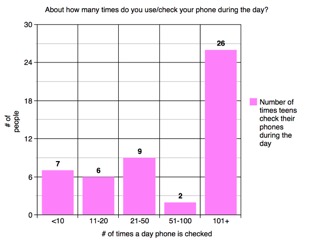 Buzzfeed update. Consequently, that is causing teens to rely on phones to communicate via texting and emojis. "I personally would rather talk face-to-face, only people these days can't talk in person and then I accept to text to get my point beyond without pause," Josh Martin, a 16 year old junior from Milton High School said.
Buzzfeed update. Consequently, that is causing teens to rely on phones to communicate via texting and emojis. "I personally would rather talk face-to-face, only people these days can't talk in person and then I accept to text to get my point beyond without pause," Josh Martin, a 16 year old junior from Milton High School said.
Hopefully teens will go on to cover talking face-to-face as the all-time way of communicating, even though it tin be scary at times. Even with the colorful and fun emojis and quick send messages, talking in person is the most intimate and personal fashion of communicating, and I hope it stays that fashion.
Source: https://voxatl.org/texting-vs-talking-face-face-surprising-vox-survey-results/
0 Response to "what percentage of people prefer texting than face to face interactio"
Enregistrer un commentaire